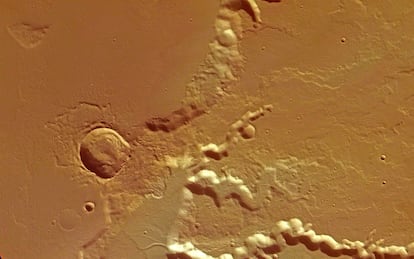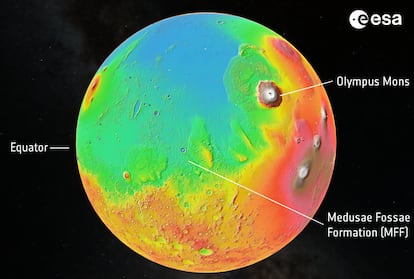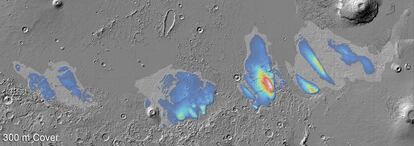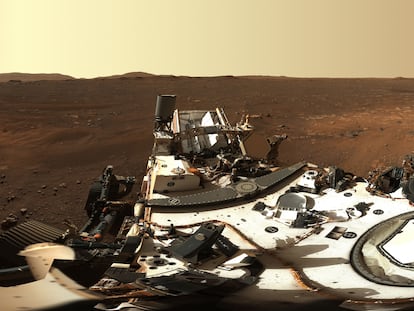Massive deposits of water ice discovered on the equator of Mars
These deposits, which would be enough to fill the Red Sea, could be used by astronauts on exploration missions and to study the possible existence of life on the Red Planet

It all started when Giovanni Schiaparelli’s planets aligned. The Italian astronomer took advantage of the fact that, in 1877, the Earth and Mars were on the same side of the Sun and at the minimum distance between the two to draw a series of maps of the neighboring planet. In them, he presented a network of lines that he called canali (channels) that unleashed wild speculation about their origin — perhaps drilled by a Martian civilization — and what type of liquid flowed through them. Almost a century and a half later, evidence to support the existence of water on the Red Planet is accumulating, offering significant opportunities for human exploration and the search for life on Mars. A mission from the European Space Agency (ESA) has detected clear evidence of the existence of massive blocks of ice in the flat, equatorial area of the planet, which is also the most accessible for landings.
The Mars Express probe, which the ESA sent to the planet in 2003, detected large underground deposits in 2007 in the windy region known as the Medusae Fossae Formation, but could not determine whether they contained volcanic dust or other types of sediments. Now, the same instrument and the same scientists, thanks to new radar sweeps over the formation, present clear indications that gigantic ice deposits are hidden beneath the surface. And they are much larger than what was initially measured: potentially between 219,000 and 396,000 cubic kilometers of frozen water. Were it to melt, it would flood the entire planet under a layer of about two meters of water. Its volume is greater than all the fresh water on Earth contained in rivers and lakes, and would be enough to fill the Red Sea.
“It could be a very valuable resource for future human exploration,” says Thomas Watters, a scientist at the Smithsonian Institution. Water is a very precious commodity for future planetary exploration, not only to relieve the thirst of astronauts, but also as a source of fuel. “It has the advantage of being located on the equator of Mars and in the northern lowlands, ideal as landing sites,” the main author of the study, carried out with the Italian Space Agency’s MARSIS equipment, adds in response to EL PAÍS. “Medusae Fossae’s ice-rich deposits could help explain where the large volume of water that helped reshape the surface of Mars ended up,” Watters says, referring to channels and other geological formations.

In 2018, Mars Express located a large lake of liquid water under the Martian polar ice. But these newly discovered massive ice deposits, the largest outside the poles, are in a much more accessible point on the planet. The Medusae Fossae are on the smooth plains of a region north of the equator, far from the dangerous mountainous terrain to the south where there are many craters that could jeopardize a landing. As Alberto González Fairén, a researcher at the Center for Astrobiology in Madrid and at Cornell University in New York, points out, one of these deposits is just 500 kilometers (310 miles) from the Gale Crater, “where we have had the Curiosity rover exploring the terrain for more than 11 years.”
“It is a very interesting discovery,” adds Fairén. “It confirms what we have learned in recent decades: these massive ice deposits, if confirmed to be so, confirm that Mars was once a planet very rich in liquid water. If the data are confirmed, it would be additional evidence that Mars was a world somewhat more similar to Earth in the past.” Watters’ team states in its study, published in Geophysical Research Letters, that the signals returned by the MARSIS radar about these deposits can only be explained by the presence of ice, and that they are very similar to those captured in the discovery of Martian polar ice. “Very dirty ice, but water ice. If it is confirmed,” insists Fairén, who notes that the MARSIS team is carrying out complementary investigations to corroborate the findings.
Life and astronauts
“It would be of exceptional importance, since it would be ice that could be accessible in the future, in the region of the planet where it is less complicated to land, and where there are more hours of sunshine and the winters are less freezing. It would be an exceptional location to begin exploration with astronauts,” notes Fairén. The Artemis program, promoted by NASA and supported by 30 countries, aims to take a manned mission to Mars well into the 2030s, but the first step of the project is to set foot on the moon again this decade, plans that have been delayed.

Life on Mars
This ice may provide clues to the climatic history of Mars, how it became so arid, and what became of the seas that once covered its surface. But water, above all, is a key element for life as we know it. The possible existence of life on Mars in the past, when it resembled Earth, but also today. “When there is water, even water ice, life or evidence of past life is possible. Unfortunately, if we are right about the thickness of the dry layer, it will be a challenge to obtain a sample of the ice core,” Watters acknowledges. For Fairén, “interest focuses on the possibility of current life.” With water ice at such low latitudes, it is possible that melt pockets habitable by microorganisms may occur, at least temporarily. “Of course, for Martian life to exist today, the conditions for biogenesis would have to have been met very early in the geological history of Mars, and that is an enormous question that we are not yet in a position to resolve,” notes Fairén.
Watters is committed to sending new missions to the area to be able to clear up the mysteries of the ice, in “an excellent site for future explorations with rovers.” “Instruments like ground-penetrating radar would be a good start, and a drill would be the most direct way to sample the deposits,” he proposes, “but it would be a significant challenge for a robotic mission.” Fairén agrees, given that the ice is under layers of between 300 and 600 meters of land: “The reality is that access to all these deposits is, today, unfeasible. The technology to install drills on Mars capable of reaching hundreds of meters deep is not yet available.”
However, the researcher warns that this discovery poses another challenge for astrobiology: “We must take extreme precautions to not introduce on Mars, via our exploration vehicles, terrestrial life that could accommodate itself in these interfaces. If we contaminate Mars, it would be very difficult to find an answer to the enormous question of whether there ever was Martian life.” The colonizing spirit of some space plans, with more haste than thought, could forever ruin the dream of understanding whether something living inhabited Schiaparelli’s canali.
Sign up for our weekly newsletter to get more English-language news coverage from EL PAÍS USA Edition









































